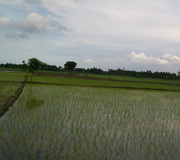Climate Change and ecological assets in the South East Asia region

Rice field in South East Asia
Can we develop a spatially explicit systematic process to ensure that conservation policy takes livelihoods and the realities of climate change into consideration?
- What did the project do?
- What did the project produce?
- How can the project make a difference to development?
- Publications
What did the project do?
Australian research team members worked with scientists and policy makers from Cambodia, Indonesia, Philippines, and Vietnam to develop and evaluate a systematic process for making conservation policy that takes climate change, regional social and ecological attributes, and poverty reduction into consideration, in South East Asia (SEA).
What did the project produce?
The team worked with international team members to facilitate the development of a scalable, nested classification system in a GIS that incorporates biophysical attributes with socio-economic trends and then projects changes due to aspects of climate change. These activities, conducted in a workshop, enabled the team to propose and discuss the general implications for conservation, sustainable resource use, and livelihoods.
Some SEA team members took this process back to their countries to examine the issues and opportunities in greater detail. The Australian team members continued to contribute to the ongoing process. The team presented a small portion of the research at the Copenhagen science congress, Climate Change: Global Risks, Challenges and Decisions (http://climatecongress.ku.dk), a precursor to the UN Conference on Climate Change.
How can the project make a difference to development?
Most SEA governments have identified that poverty reduction, particularly through natural resource management and agriculture is of strategic importance. Protection of natural resources from non-sustainable use and the detrimental effects of climate change is critical to achieving this. Climate change and non-sustainable resource use has the potential to drastically affect the resource base of the economy of these countries. We seek to enable SEA governments to make effective conservation and sustainable use policy in a systematic manner, taking livelihood issues, demographic trends, and climate change into account.
Publications
Booth, T. H. & Jovanovic, T. & Son Ho, N. & Miller, C. (2012) A systematic regional approach for climate change adaptation to protect biodiversity. Climatic Change 12pp. DOI 10.1007/s10584-012-0568-4.
Miller, C. et al (2009) Towards Regionally Relevant Biodiversity,Poverty and Climate Change Policy: A Report on the Los Banos Workshop, A report produced for CSIRO Climate Adaptation Flagship. Brisbane. Australia.
Miller, C., Alexander, K.S. Jovanovic, T. (2009) Tigum-Aganan Watershed Management Project.
A report in two parts prepared for the CSIRO Climate Adaptation Flagship.


